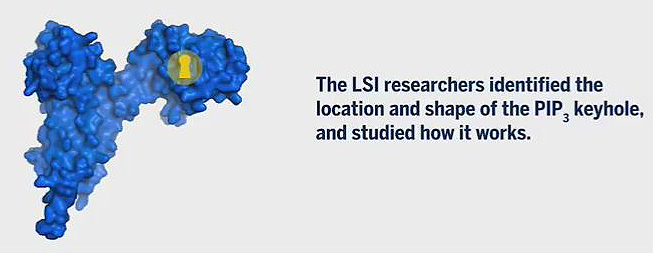Click here to watch a University of Michigan video about this discovery.
The original University of Michigan press release by Ian Demsk can be read here.
Most cancer drugs today work by attacking tumor growth. Researchers from the University of Michigan Life Sciences Institute (LSI), utilizing the U.S. Department of Energy’s Advanced Photon Source (APS), an Office of Science user facility at Argonne, are taking aim at a different piece of the cancer puzzle: preventing its ability to spread to new parts of the body, known as “metastasis,” which is the cause of most cancer deaths. Their results were published in the journal Structure.
These scientists focused on an enzyme known as P-Rex1, which has been strongly linked to cancer progression and metastasis in breast, prostate and skin cancer, making it an attractive target for new drugs.
Tumor cells in certain types of cancer produce high levels of P-Rex1, including more than 50 percent of breast cancers. And it's the activation of P-Rex1 by two other molecules that allows the cancer cells to become mobile and spread.
“P-Rex is like a machine that requires two keys to turn on,” said lead study author Jennifer Cash, a postdoctoral fellow in the LSI lab of co-author John J.G. Tesmer. “A new drug could come in the form of a key that could fit into one of the locks and block it from being turned on. But to develop that new drug, first you have to have a detailed understanding of what that lock looks like and how it functions.”
The researchers used x-ray crystallography at the Life Sciences Collaborative Access Team 21-ID-D beamline at the APS to reveal P-Rex1's three-dimensional structure and functional characteristics. Their findings, published April 14 in the journal Structure, focused on the binding site for one of the keys, a signaling lipid called PIP3.
“P-Rex1 has been an attractive drug target for some time,” said Tesmer. “But development of these drugs has been hindered by a lack of understanding of its structure and regulatory mechanisms. Our data have confirmed the location of the binding site, which will greatly assist with the identification or design of small molecules that target this mechanism of activation.”
Another reason P-Rex1 is an attractive target is that mice that have been genetically altered to lack the enzyme are generally healthy and suffered few adverse effects, the researchers noted.
While the type of laboratory research that Cash and her collaborators tackle is quite specialized and technical — replete with terms like “pleckstrin homology domain” and “allosteric activation mechanism” — she said it's easy for her to look beyond the intricate details of the science and to keep the big picture in mind.
“My life has been touched by breast cancer,” said Cash. “I've had multiple family members who have lost the fight against breast cancer, and my sister was just recently diagnosed with breast cancer. The most common gene mutation in hereditary breast cancer runs in my husband's family, and I have two little girls at home. So for me — like for so many families — it's very personal.”
The next step in the research is to begin screening for drug-like molecules able to bind to P-Rex1 at the PIP3 binding site, preventing the enzyme's activation.
See: Jennifer N. Cash1, Ellen M. Davis1, and John J.G. Tesmer1,*, “Structural and Biochemical Characterization of the Catalytic Core of the Metastatic Factor P-Rex1 and Its Regulation by PtdIns(3,4,5)P3,” Structure 24, 1, (2016). DOI: /10.1016/j.str.2016.02.022
Author affiliation: University of Michigan
Correspondence: *[email protected]
This work was supported in part by National Institutes of Health grants HL086865 and HL122416 to J.T., an American Cancer Society-Michigan Cancer Research Fund Postdoctoral Fellowship (PF-14-224-01-DMC) to J.C., and an American Heart Association Undergraduate Student Research Program Award (14UFEL20510027) to E.D. Use of the Life Sciences Collaborative Access Team was supported by the Michigan Economic Development Corporation and the Michigan Technology Tri-Corridor (Grant 085P1000817). This research used resources of the Advanced Photon Source, a U.S. Department of Energy (DOE) Office of Science User Facility operated for the DOE Office of Science by Argonne National Laboratory under Contract No. DE-AC02-06CH11357.
Argonne National Laboratory seeks solutions to pressing national problems in science and technology. The nation’s first national laboratory, Argonne conducts leading-edge basic and applied scientific research in virtually every scientific discipline. Argonne researchers work closely with researchers from hundreds of companies, universities, and federal, state and municipal agencies to help them solve their specific problems, advance America’s scientific leadership and prepare the nation for a better future. With employees from more than 60 nations, Argonne is managed by UChicago Argonne, LLC for the U.S. Department of Energy’s Office of Science.
The U.S. Department of Energy’s Office of Science is the single largest supporter of basic research in the physical sciences in the United States and is working to address some of the most pressing challenges of our time. For more information, visit the Office of Science website.

